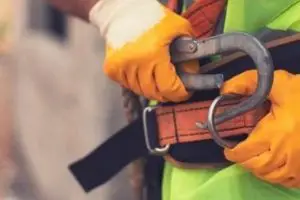We all know that feeling when you’re about to start a project and realize you don’t have all the necessary safety equipment. Here’s a quick checklist to help make sure you’re prepared for anything.
How to Conduct a Fall Protection Check
Conducting a fall protection check is vital to ensure the safety of your employees. While most checks are conducted on an annual basis, it’s important to check the equipment more frequently if it’s being used regularly.
Here’s a quick checklist of items you should consider when developing your fall protection plan:
1. Evaluate the job site and identify potential fall hazards. Determine the height of the fall hazard and the distance that workers will be exposed to it. This will require assessing the type of terrain and surface conditions where the work will be taking place. Identify any additional hazards that could potentially contribute to a fall, such as slippery surfaces or overhead obstacles.
2. Implement engineering controls to eliminate or minimize exposure to fall hazards (e.g., guardrails, scaffolds, nets).
3. Provide personal protective equipment (PPE) to workers who are exposed to fall hazards (e.g., harnesses, lanyards). Choose a fall protection system that is appropriate for the specific circumstances and ensure that all workers are properly trained in its use.
4. Ensure that workers who are exposed to fall hazards are properly trained in the use of PPE and fall arrest systems.
5. Monitor conditions at the job site and make adjustments to the fall protection plan as needed. Replace any worn or damaged parts of the fall protection systems.
Use this checklist to make sure all the essential components of a fall protection system are in good working condition.
Important fall protection components to inspect and monitor
While performing your inspection check, pay attention to the following key components:
- Anchor Points: Check for rust, corrosion, or damage.
- Connecting Devices: Inspect for wear and tear, and make sure all connections are secure.
- Body Support Systems: Ensure that there are no tears or holes in the harnesses or lanyards.
- Retrieval Systems: Check that winches and pulleys are functioning properly.
- Fall arrest device: Test your fall arrest device (such as a shock-absorbing lanyard) by gently dropping it from shoulder height. If it does not deploy properly, replace it immediately.
What are the Different Types of Fall Protection?
Most people are familiar with the standard fall protection used in construction and other industries – the safety harness. But there are actually several different types of fall protection, each with its own advantages and disadvantages.
The most common types of fall protection are:
Safety Harnesses: A safety harness is the most common type of fall protection. It is a device that is worn by the worker and is attached to an anchorage point to prevent the worker from falling.
Lanyards: A lanyard is a cable or rope that is used to connect the worker to an anchorage point. Lanyards can be made of different materials, such as steel or nylon, and can be either adjustable or non-adjustable.
Lifelines: A lifeline is a cable or rope that is placed between two fixed points, such as the roof and floor of a building, to create an anchor point for workers. Lifelines can be made of different materials, such as steel or nylon, and can be either adjustable or non-adjustable.
Anchorage Points: Anchorage points are fixed points that are used to attach lanyards and lifelines to prevent workers from falling. Anchorage points can be made of different materials, such as steel or concrete, and can be either permanent or temporary.
Each type of fall protection has its own advantages and disadvantages, so it is important to choose the type that is best suited for the job at hand.
What is the Key Component of a Fall Protection System?
A fall protection system is made up of several different components, all of which work together to provide protection for workers in the event of a fall. The most important component is the anchor, which is used to attach the fall protection system to a solid structure. Other key components include lanyards, connectors, and body belts or harnesses.
Why is Fall Protection Important?
The leading cause of death in construction is falling, and falls from heights continue to be a serious hazard in many other industries as well. In fact, the Bureau of Labor Statistics estimates that there are around 700 fatal falls and 25,000 nonfatal injuries each year in the United States alone.
Most falls can be prevented with the use of proper fall protection equipment and protocols. By understanding the potential hazards and taking measures to protect workers, employers can create a safe work environment and reduce the risk of catastrophic accidents.
Accidents and falls are preventable
Although falls from height continue to kill and injure many construction workers each year, fortunately, most of these incidents are preventable. The first step in preventing falls is to eliminate hazards that could cause a worker to lose his or her balance and fall. But even when you have eliminated all fall hazards, there are still circumstances that could result in a fall. That’s why it’s important to have a fall protection plan in place.
Conclusion
Now that you have a quick fall protection checklist and know each of the key components, you can start to set up a fall protection system and ensure that it remains up to par. Be sure to check each item off as you inspect it and make note of any repairs or replacement that may be necessary.
NEXT UP: Jobs That Require Welding Gloves

